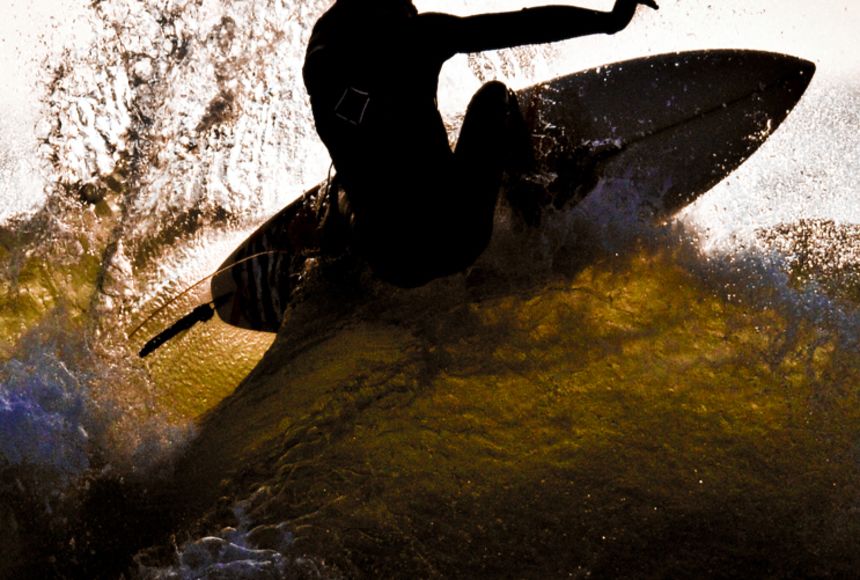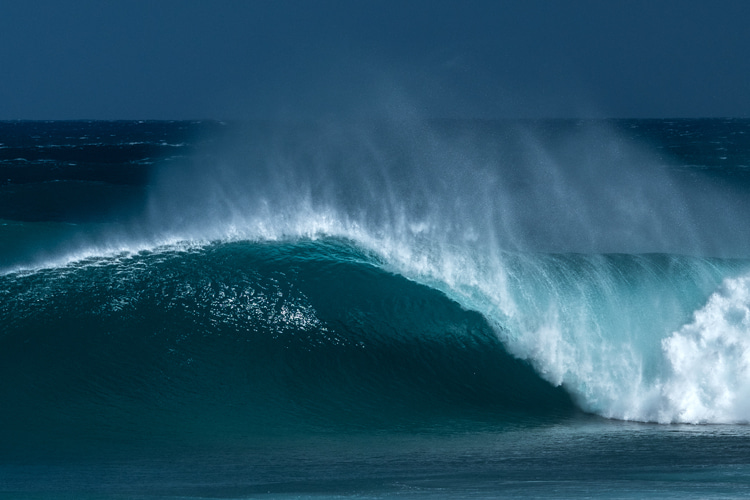Waves can break left or right depending on the direction of their approach towards the shore. However, the breaking direction is also influenced by the shape of the seafloor and any underwater obstacles that might affect the wave’s movement.
Waves are a natural phenomenon created by the wind as it pushes against the surface of the ocean. They come in different sizes and shapes and move in different directions. One of the key features of a wave is the point where it breaks, which is the point where the wave crest topples over and crashes into the shore. The breaking direction can be influenced by various factors, including the shape and slope of the beach, the angle of approach of the wave, and the presence of any underwater obstacles, such as rocks or sandbars. Understanding these factors is essential for surfers and ocean enthusiasts who want to ride the waves and stay safe while doing so.

Credit: www.nationalgeographic.org
Exploring The Different Types Of Waves
Have you ever wondered how waves form and break? Do waves always break from left to right? In this blog post, we will explore the different types of waves and understand the science behind how they form. Let’s get started!
Understanding The Science Behind How Waves Form
- Waves are formed by energy traveling through water. This could be from wind blowing over the surface, earthquakes, or other disturbances.
- The size and shape of waves depend on the speed, direction, and duration of the wind that initially created them.
- Waves have two main parts: the crest (the highest point of the wave) and the trough (the lowest point of the wave).
- As waves approach the shore, they slow down, and their height increases, which causes them to break.
Discussing The Different Types Of Waves
There are two main types of waves: groundswells and windswells.
Groundswells
- Groundswells are created by distant weather systems, such as storms, and they travel long distances to reach the coast.
- They tend to be more consistent in size, direction, and power than windswells.
- The energy of groundswells is generated by the wind over a large area of water, resulting in a longer period between waves.
Windswells
- Windswells are created by local wind patterns and are usually shorter in distance and duration, resulting in smaller waves.
- They are more influenced by the winds nearest to the shore, resulting in more erratic wave patterns.
- The energy of windswells is generated by the wind over a short area of water, resulting in a shorter period between waves.
Waves do not always break left to right, as their direction and shape depend on various factors such as wind patterns and shorelines. However, understanding the two main types of waves, groundswells and windswells, and the science behind how they form, can help predict their behavior and make surfing a more enjoyable experience.
Wave Refraction And Its Influence On Breaking Direction
Defining Wave Refraction And How It Affects Waves
Waves are formed due to the movement of wind over the surface of the ocean. However, their direction can be significantly affected by refraction caused by changes in the ocean floor.
- Wave refraction is the bending of waves as they travel from deep water to shallow water along the coast.
- Refraction occurs because waves move more slowly in shallower water, causing the part of the wave closest to shore to slow down, while the rest of the wave continues to move at the same speed.
- The bending of waves changes their direction, making them move more parallel to the shoreline.
The Role Of The Ocean Floor In Wave Refraction
Different ocean floor topography, such as the presence of reefs or sandbars, can affect the direction of waves.
- Shallow sandbars and banks cause waves to break earlier, making them break closer to shore.
- Reefs and other shallow formations can cause waves to break more quickly and intensely, creating better surfing conditions.
- Deep channels in the ocean floor can cause waves to refract and converge, creating dangerous rip currents.
Discussing How Refraction Plays A Role In The Direction Of Wave Breaks And If Waves Generally Break Left To Right
Wave refraction plays a significant role in the direction of wave breaks. It causes waves to move more parallel to the shore, and the direction of their break can vary.
- The direction of wave break depends on the shape of the shoreline and the direction of the incoming waves.
- If the shore is concave (curving in), waves tend to break left to right and vice versa for convex shores (curving out).
- However, swell direction, ocean floor characteristics, and wind directions can all impact the direction of the wave break.
Understanding wave refraction and its influence on the direction of wave breaks can help surfers, swimmers, and beachgoers stay safe and enjoy the ocean’s beauty fully.
The physics of surfing – Nick Pizzo
Wave Sets And Their Impact On Breaking Patterns
Waves are fascinating, with their rhythmic movements and varying patterns. But have you ever wondered if waves break left to right or right to left? This article focuses on breaking patterns and wave sets to answer that question.
Understanding The Concept Of Wave Sets
Before diving into how wave sets impact wave breaks, it’s essential to define the concept. A wave set is a group of waves that arrive at a coast in a specific time frame. Wave sets are characterized by their height, period, and direction, and they can be influenced by different factors such as wind, tides, and swells.
Analyzing How Wave Sets Can Impact Wave Breaks
Wave sets can impact wave breaks in several ways.
- The period of wave sets can affect the shape of the wave, determining whether they break left to right or right to left.
- If a set with long period and high energy hits a beach with a steep slope, it can create a right-breaking wave. Conversely, if a set with short period and low energy hits a beach with a gentle slope, it can create a left-breaking wave.
- The angle of wave sets can also determine the breaking pattern. If the angle is perpendicular to the beach, waves will break uniformly, but if the angle is acute or obtuse, it can create left or right-breaking waves, respectively.
Discussing Wave Sets And Their Relation To Waves Breaking Left To Right
The way wave sets impact wave breaks comes down to the combination of period, direction, and slope of the beach.
- Left-breaking waves tend to occur on beaches with a gentle slope, short-period sets, and high-energy waves.
- Right-breaking waves tend to occur on beaches with a steep slope, long-period sets, and high-energy waves.
In short, waves can break left to right or vice versa, and this breaking pattern depends on the wave set’s characteristics. Therefore, next time you’re at the beach, pay attention to the waves’ movements, and see if you can identify their breaking pattern.
The Relationship Between Swell Direction And Breaking Waves
Waves are an incredible sight to behold. As they crash onto the shore, they provide a sense of peace and calmness. However, did you know that the direction they break? To understand this, we need to analyze the relationship between swell direction and breaking waves, which is one of the most essential components of understanding how waves break.
In this post, we will dive deeper into the topic to help you understand it more clearly.
Defining Swell Direction And Its Impact On Wave Breaks
Before we explore the relationship between swell direction and waves breaking, let’s define what swell direction is. Swell direction is the direction from which a wave has traveled to reach the point of observation. This is essential in understanding how waves break.
- Swell is the outcome of far-off winds and storms in the ocean, which travel hundreds and even thousands of miles.
- The direction of the swell is crucial in determining how it will break on the shore.
- The angle at which the swell approaches the beach determines the direction it breaks.
Analyzing The Relationship Between Swell Direction And Waves Breaking Left To Right
It is natural to believe that most waves break towards the shore straight on. Still, the reality is a bit different. The direction of the wave break depends on the angle of the swell.
- When swell approaches the shore at a straight angle, waves break evenly to the right and left, and surfers can ride either way.
- Waves that break towards the left mean that the swell is approaching from the right of the beach, and vice versa.
- If the swell is approaching from an angle, it causes a rideable wave that will break in one direction, resulting in a long ride in one direction.
- Swell direction can determine which coastal areas experience stronger waves.
Understanding How The Weather And Other Factors Affect The Impact Of Swell Direction On Breaking Waves
While swell direction plays a critical role in the direction of wave breaks, other factors can impact the power and intensity of the waves.
- Local weather and water depth can influence the direction of wave break, making it erratic and irregular.
- The shape of the shoreline, the kind of bottom and any obstacles in its way can also affect the shape and direction of wave breaks.
- Swell size and speed can also influence the way waves behave when they reach the shore.
Understanding the relationship between swell direction and breaking waves is important if you intend to ride waves or observe them. Factors such as wind direction, swell size, and other aspects of the weather must also be taken into account to get the most out of your wave-riding experience.
Conclusion
Surfing is a thrilling activity, and wave formation can be a complex subject to understand for surfers and non-surfers alike. Waves do not break left or right on their own; the direction of the wave-breaking is determined by the direction the swell is traveling.
Several factors come into play, including wind speed, wind direction, and the shape of the seafloor to create a left or right-breaking wave. The bottom line is that a surfer’s experience of the perfect wave is determined by a series of natural events that converge with the surfer at just the right moment.
While it may seem like magic for those who have never surfed, understanding the mechanics of waves is a critical component of becoming a skilled surfer. So, go ahead and hit the waves, and dare to break left or right, but remember to embrace the beauty of nature’s forces that make it all possible.



